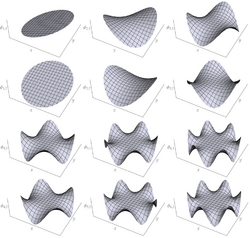Harmonic polynomial
In mathematics, in abstract algebra, a multivariate polynomial p over a field such that the Laplacian of p is zero is termed a harmonic polynomial.[1][2] The harmonic polynomials form a vector subspace of the vector space of polynomials over the field. In fact, they form a graded subspace.[3] For the real field, the harmonic polynomials are important in mathematical physics.[4][5][6]
The Laplacian is the sum of second partials with respect to all the variables, and is an invariant differential operator under the action of the orthogonal group via the group of rotations.
The standard separation of variables theorem[citation needed] states that every multivariate polynomial over a field can be decomposed as a finite sum of products of a radial polynomial and a harmonic polynomial. This is equivalent to the statement that the polynomial ring is a free module over the ring of radial polynomials.[7]
Examples
Consider a degree-[math]\displaystyle{ d }[/math] univariate polynomial [math]\displaystyle{ p(x) := \textstyle\sum_{k=0}^d a_k x^k }[/math]. In order to be harmonic, this polynomial must satisfy
[math]\displaystyle{ 0 = \tfrac{\partial^2}{\partial x^2} p(x) = \sum_{k=2}^d k(k-1) a_k x^{k-2} }[/math]
at all points [math]\displaystyle{ x \in \mathbb{R} }[/math]. In particular, when [math]\displaystyle{ d=2 }[/math], we have a polynomial [math]\displaystyle{ p(x) = a_0 + a_1 x + a_2 x^2 }[/math], which must satisfy the condition [math]\displaystyle{ a_2 = 0 }[/math]. Hence, the only harmonic polynomials of one (real) variable are affine functions [math]\displaystyle{ x \mapsto a_0 + a_1 x }[/math].
In the multivariable case, one finds nontrivial spaces of harmonic polynomials. Consider for instance the bivariate quadratic polynomial
[math]\displaystyle{ p(x,y) := a_{0,0} + a_{1,0} x + a_{0,1} y + a_{1,1} x y + a_{2,0} x^2 + a_{0,2} y^2, }[/math]
where [math]\displaystyle{ a_{0,0}, a_{1,0}, a_{0,1}, a_{1,1}, a_{2,0}, a_{0,2} }[/math] are real coefficients. The Laplacian of this polynomial is given by
[math]\displaystyle{ \Delta p(x,y) = \tfrac{\partial^2}{\partial x^2} p(x,y) + \tfrac{\partial^2}{\partial y^2} p(x,y) = 2(a_{2,0} + a_{0,2}). }[/math]
Hence, in order for [math]\displaystyle{ p(x,y) }[/math] to be harmonic, its coefficients need only satisfy the relationship [math]\displaystyle{ a_{2,0} = -a_{0,2} }[/math]. Equivalently, all (real) quadratic bivariate harmonic polynomials are linear combinations of the polynomials
[math]\displaystyle{ 1, \quad x, \quad y, \quad xy, \quad x^2 - y^2. }[/math]
Note that, as in any vector space, there are other choices of basis for this same space of polynomials.
A basis for real bivariate harmonic polynomials up to degree 6 is given as follows:
[math]\displaystyle{ \begin{array}{rcl} \phi_{0} (x,y) &:=& 1 \\ \phi_{1,1}(x,y) &:=& x \\ \phi_{1,2}(x,y) &:=& y \\ \phi_{2,1}(x,y) &:=& x y \\ \phi_{2,2}(x,y) &:=& x^2-y^2 \\ \phi_{3,1}(x,y) &:=& y^3-3 x^2 y \\ \phi_{3,2}(x,y) &:=& x^3-3 x y^2 \\ \phi_{4,1}(x,y) &:=& x^3 y-x y^3 \\ \phi_{4,2}(x,y) &:=& -x^4+6 x^2 y^2-y^4 \\ \phi_{5,1}(x,y) &:=& 5 x^4 y-10 x^2 y^3+y^5 \\ \phi_{5,2}(x,y) &:=& x^5-10 x^3 y^2+5 x y^4 \\ \phi_{6,1}(x,y) &:=& 3 x^5 y-10 x^3 y^3+3 x y^5 \\ \phi_{6,2}(x,y) &:=& -x^6+15 x^4 y^2-15 x^2 y^4+y^6 \\ \end{array} }[/math]
See also
References
- ↑ Walsh, J. L. (1927). "On the Expansion of Harmonic Functions in Terms of Harmonic Polynomials". Proceedings of the National Academy of Sciences 13 (4): 175–180. doi:10.1073/pnas.13.4.175. PMID 16577046. Bibcode: 1927PNAS...13..175W.
- ↑ Helgason, Sigurdur (2003). "Chapter III. Invariants and Harmonic Polynomials". Groups and Geometric Analysis: Integral Geometry, Invariant Differential Operators, and Spherical Functions. Mathematical Surveys and Monographs, vol. 83. American Mathematical Society. pp. 345–384. ISBN 9780821826737. https://books.google.com/books?id=WuDyBwAAQBAJ&pg=345.
- ↑ Felder, Giovanni; Veselov, Alexander P. (2001). "Action of Coxeter groups on m-harmonic polynomials and KZ equations". arXiv:math/0108012.
- ↑ Sobolev, Sergeĭ Lʹvovich (2016). Partial Differential Equations of Mathematical Physics. International Series of Monographs in Pure and Applied Mathematics. Elsevier. pp. 401–408. ISBN 9781483181363. https://books.google.com/books?id=P-xPDAAAQBAJ&pg=PA401.
- ↑ Whittaker, Edmund T. (1903). "On the partial differential equations of mathematical physics". Mathematische Annalen 57 (3): 333–355. doi:10.1007/bf01444290. https://babel.hathitrust.org/cgi/pt?id=njp.32101080167032;view=1up;seq=351.
- ↑ Byerly, William Elwood (1893). "Chapter VI. Spherical Harmonics". An Elementary Treatise on Fourier's Series, and Spherical, Cylindrical, and Ellipsoidal Harmonics, with Applications to Problems in Mathematical Physics. Dover. pp. 195–218. https://books.google.com/books?id=BMQ0AQAAMAAJ&pg=PA195.
- ↑ Cf. Corollary 1.8 of Axler, Sheldon; Ramey, Wade (1995), Harmonic Polynomials and Dirichlet-Type Problems
- Lie Group Representations of Polynomial Rings by Bertram Kostant published in the American Journal of Mathematics Vol 85 No 3 (July 1963) doi:10.2307/2373130
 |


